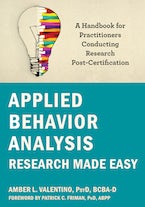By Amber L. Valentino, PsyD, BCBA-D, author of Applied Behavior Analysis Research Made Easy
I’ll never forget the day I received an email informing me that my first article had been accepted for publication. I was a new BCBA, and was pursuing a career as a practitioner. I never dreamed I’d be a researcher, but there I was, acceptance letter in hand, beaming with pride! I printed that acceptance letter, put it on my fridge, and checked the final article daily to be sure it was indeed my name printed as the author! (It was!) After that one publication, I was hooked! I knew that contributing to the profession through applied research was something I wanted to continue doing for the remainder of my career.
Here I am today still contributing to the research literature regularly many years after that fateful day. But the road hasn’t always been easy. I’ve never worked in academia, and I’ve never had research specifically carved out as an exception of my role. In fact, for many years, my day-to-day job responsibilities seemed to actively interfere with my research interests. I am happy to say that I found a way to persist and to be successful in the publishing world. But over the years, I’ve learned that my experience is not common to most practitioners. That is, I meet a lot of practitioners who strongly desire to publish. The motivation is so strong! They are interested, willing to put in extra time, and commit a lot of energy to the task. But, unfortunately, very few of them publish. This begs the question: If someone is that motivated (as most of the practitioners in our profession are!) and they’re willing to put in the work, why do they never actually become researchers? There are a lot of barriers practitioners face when trying to conduct research amidst their clinical practice. Luckily, there are ways to overcome these barriers and to have a fruitful and lifelong research career. Here are five tips for seeing your own name on that acceptance letter and getting hooked on publishing:
Tip #1: Identify a mentor.
Our profession is filled with amazing people who do amazing work every day to move the field along. Truly, it’s amazing! When I speak with people outside the profession of behavior analysis, they’re amazed at how much our group does for “free” in the name of contributing to the science. And a huge part of that philanthropy involves teaching, mentoring, and training the next generation of behavior analysts. There are a lot of amazing behavior analysts who conduct research every day who want nothing more than to help junior people in the field! Whether it be through a formal mentoring relationship established through further education, or simply an informal one established through good, old-fashioned connections, mentors can be an amazing resource for getting started in the publishing world. Don’t be scared to ask someone you respect if they will support your development in some way. Having a mentor—particularly in the early stages of publishing—can make a huge difference in your ability to get some early projects off the ground and running!
Tip #2: View your clinical questions as research questions.
All too often, we divide our work into clinical and research. But good practitioner researchers never do this! They view these worlds as one in the same. That is, if you have a clinical question, you can (and should) turn it into a research question. This will lead you on a path of constructing your clinical work in a way that supports it being not only a solid research study, but also excellent clinical practice. Of course, not every clinical question will turn into a research publication, but several of them absolutely can! Successful applied researchers ask dozens and dozens of questions every day, and a subset of those actually become research studies that go on to make it into the peer-reviewed literature. But, that can’t happen if you don’t ask the question in the first place—and think about the work you do every day as a scientific research question to solve!
Tip #3: Make time and commit to it.
I have a difficult thing to tell you: You’re never going to wake up one day and suddenly have more time or free time. It just isn’t going to happen. So, if you want to conduct applied research, you must make time for it and truly commit to that time being used for this purpose. Lack of time has been noted as the number one barrier behavior analyst practitioners identify as stopping them from conducting research. But it doesn’t have to be. Even blocking just one session per week can help you make movement. They key is consistency—that is, putting in the time week over week, month over month, and year over year. I’m a big fan of time blocking—that is, dedicating a certain amount of time for research regularly and setting small goals for myself related to the projects I have going on. I personally focus on research-related tasks for one hour per day, five days per week. That’s a relatively small amount of time when you think about it—but five hours every week really adds up! With a very concrete task list in hand, I’ve been able to publish anywhere from two to eight articles per year for the past eleven years! Your commitment doesn’t have to be daily. You could choose just one hour per week to get started. Once you choose it, protect the time, and use it to truly focus on your research agenda. I promise, you’ll make progress.
Tip #4: See small behaviors as big movement.
Many behavior analysts I speak with have a difficult time getting started on their research path. A primary reason for this difficulty is that they don’t see the “little” things they need to do as important enough to put them on a list, do them, and consider them research. These are tasks like finding an article, downloading the article, reading the abstract, sending an email to collaborate with someone, and organizing a shared folder. But you know what? These are ALL research tasks. They all need to get done, right? And they all relate to your research agenda in some way, right? So, start with that list—do your task analysis and set goals for yourself to do tasks during your research time. You’ll build a lot of momentum that way, and those “little” things will turn into “big” things—papers, presentations, and even publications!
Tip #5: Read a lot to write a lot.
Reading makes you a better writer. So, if you’re not sure where to start on your research journey, pick an article you’re interested in and plan to read it. When you read, some amazing things happen. First, you start to get research ideas—for example, “What if they did the intervention this way instead of that?” “I wonder about that participant who didn’t respond?” “What if they added a different prompt into their treatment package?” Second, you learn! That’s right, you learn about a topic, which makes you a better researcher because you’ll be informed about the literature in an area. Finally, you get to have a great model for strong writing, research design, and science, which will greatly serve you in your own writing career. So, find a topic, find some articles, and get to reading them.
There are dozens of other ways to overcome the barriers associated with applied research so you can begin publishing. The key is acting (now!) and beginning the process. Building on the small behaviors to build to the bigger ones. So, what will you do today to start your own publishing journey?
Amber L. Valentino, PsyD, BCBA-D, currently serves as chief clinical officer at Trumpet Behavioral Health. In this role, she oversees all research and training initiatives, builds clinical standards for the organization, and structures systems for high-quality clinical service delivery. Valentino’s clinical and research interests include the assessment and treatment of verbal behavior, primarily in children with autism. She is also interested in evaluation of programming to address unique adaptive skill deficits, professional practice issues such as ethics, and developing standards for effective supervision in the field.
Valentino has spent her research career conducting applied studies and publishing in several peer-reviewed behavior analytic journals. She currently serves as an associate editor for Behavior Analysis in Practice, and previously served as associate editor for The Analysis of Verbal Behavior. She is on the editorial board of the Journal of Applied Behavior Analysis, and serves as a frequent guest reviewer for several behavior analytic journals.



 2024 Peace Playbook: 3 Tactics to Avoid Clashes with Your Partner
2024 Peace Playbook: 3 Tactics to Avoid Clashes with Your Partner